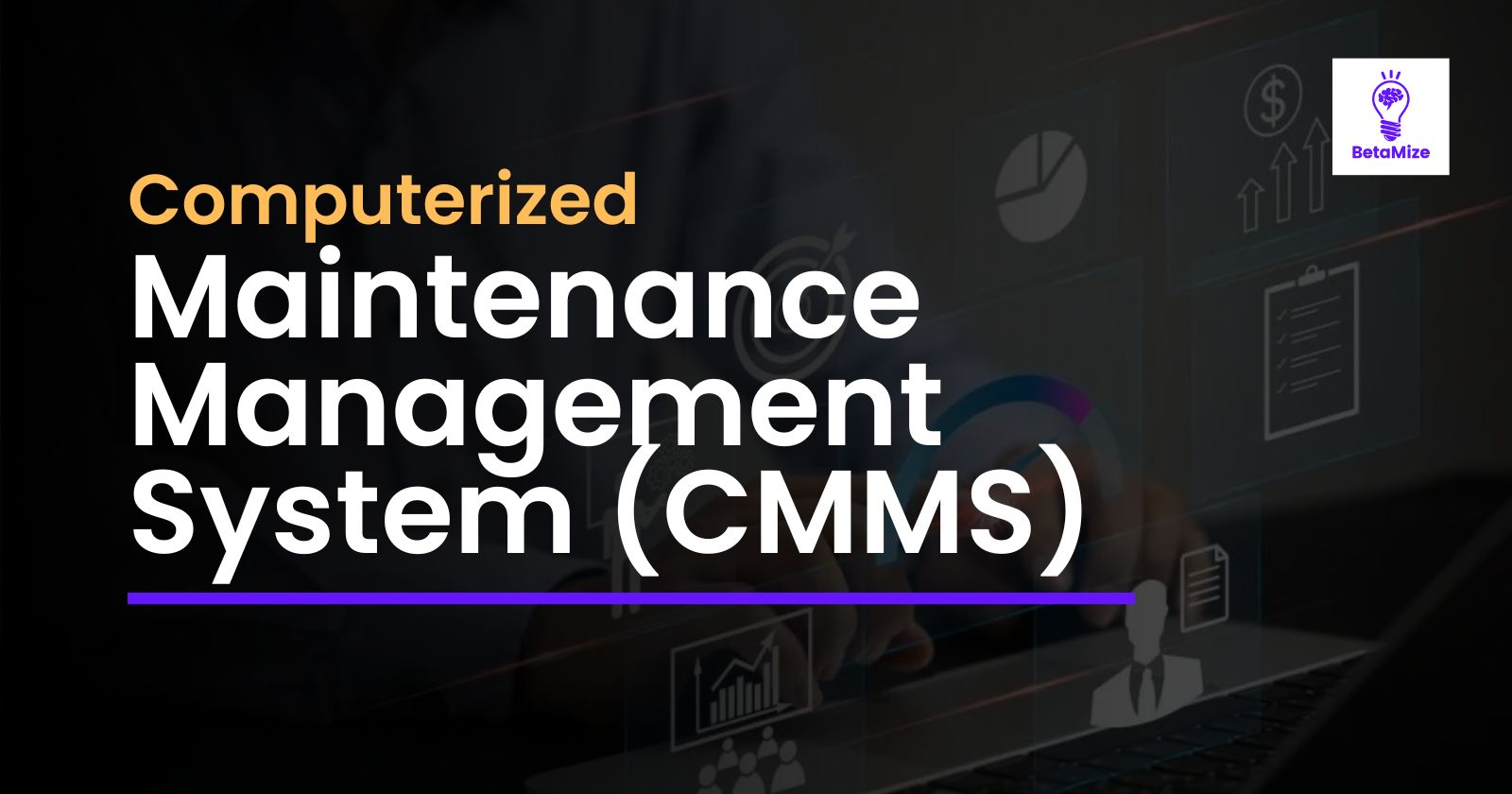What is CMMS?
 BetaMize
BetaMize
In the modern industrial landscape, the importance of maintaining equipment and machinery cannot be overstated. Downtime due to equipment failure can lead to significant production losses, increased costs, and reduced customer satisfaction. To address these challenges, many businesses are turning to Computerized Maintenance Management Systems (CMMS) to streamline and optimize their maintenance operations. In this article, we’ll explore what a CMMS is, its key features, and how it can transform your maintenance processes.
What is a Computerized Maintenance Management System (CMMS)?
A Computerized Maintenance Management System (CMMS) is a software solution designed to manage and automate maintenance tasks within an organization. It centralizes maintenance information, schedules, and processes, making it easier for maintenance teams to track and perform maintenance activities efficiently. CMMS software is widely used in industries such as manufacturing, energy, healthcare, and facilities management, where the reliability and availability of equipment are crucial to operations.
Key Features of CMMS
Work Order Management
Streamlined Processes: CMMS allows for the creation, assignment, and tracking of work orders from a centralized platform. Maintenance managers can easily prioritize tasks, assign them to specific technicians, and track their progress in real time. This ensures that maintenance tasks are completed on time and according to priority.
Detailed Documentation: Each work order can include detailed information such as the nature of the issue, required tools, spare parts, and safety instructions. This documentation helps technicians complete tasks more efficiently and reduces the likelihood of errors.
Preventive Maintenance Scheduling
Automated Scheduling: CMMS enables the automation of preventive maintenance schedules based on usage, time intervals, or condition monitoring. This proactive approach ensures that maintenance is performed regularly, reducing the risk of unexpected equipment failures.
Predictive Insights: The system can also incorporate predictive maintenance strategies by analyzing equipment data to forecast potential failures. By addressing issues before they become critical, businesses can avoid costly downtime and extend the lifespan of their equipment.
Asset Management
Comprehensive Asset Tracking: CMMS provides a detailed record of all assets within an organization, including their maintenance history, performance data, and lifecycle information. This helps businesses make informed decisions about asset utilization, maintenance, and replacement.
Optimized Resource Allocation: By analyzing asset performance data, CMMS can suggest the most efficient use of resources, such as when to retire old equipment or invest in new technology. This ensures that businesses get the most value out of their assets.
Inventory Management
Real-Time Inventory Control: CMMS tracks spare parts and materials inventory, providing real-time data on stock levels, usage rates, and reorder points. This helps prevent stockouts and ensures that the necessary parts are always available for maintenance tasks.
Cost Reduction: By optimizing inventory levels, CMMS reduces carrying costs and minimizes waste. The system can also identify obsolete inventory and suggest appropriate actions, further reducing costs.
Reporting and Analytics
Data-Driven Decisions: CMMS generates comprehensive reports and dashboards that provide insights into maintenance activities, asset performance, and overall operational efficiency. These analytics help businesses identify trends, assess the effectiveness of their maintenance strategies, and make data-driven decisions.
Regulatory Compliance: For industries with strict regulatory requirements, CMMS can generate reports that demonstrate compliance with maintenance standards. This helps businesses avoid fines and ensures they meet industry-specific regulations.
Mobile Access
Remote Accessibility: Modern CMMS solutions often include mobile apps that allow technicians to access work orders, asset information, and inventory data from their smartphones or tablets. This remote access enhances flexibility and ensures that maintenance teams can respond quickly to issues, regardless of their location.
Real-Time Updates: Technicians can update work order status, report issues, and log maintenance activities directly from the field. This real-time data entry improves communication between team members and ensures that the maintenance records are always up to date.
Integration with Other Systems
Seamless Integration: CMMS can integrate with other enterprise systems such as Enterprise Resource Planning (ERP), IoT platforms, and Building Management Systems (BMS). This integration provides a holistic view of operations, allowing businesses to optimize their entire maintenance ecosystem.
Enhanced Efficiency: By connecting CMMS with other systems, businesses can automate workflows, improve data accuracy, and reduce manual entry errors. This interconnected approach enhances overall operational efficiency.
Benefits of Implementing a CMMS
Increased Equipment Reliability:
- By ensuring that maintenance is performed regularly and proactively, CMMS helps reduce the frequency and severity of equipment failures. This leads to more reliable operations and less unplanned downtime.
Improved Maintenance Efficiency:
- With a centralized platform for managing work orders, schedules, and inventory, maintenance teams can work more efficiently. CMMS eliminates the need for paper-based processes and reduces administrative burdens.
Cost Savings:
- CMMS helps businesses reduce maintenance costs by optimizing preventive maintenance schedules, reducing downtime, and managing inventory more effectively. Predictive maintenance strategies can further reduce costs by addressing potential issues before they escalate.
Enhanced Compliance:
- For industries with stringent regulatory requirements, CMMS ensures that maintenance activities are documented and compliant with industry standards. This reduces the risk of non-compliance and associated penalties.
Data-Driven Insights:
- The analytics and reporting features of CMMS provide valuable insights into maintenance performance, asset utilization, and operational efficiency. These data-driven insights enable continuous improvement and support strategic decision-making.
Better Resource Management:
- CMMS allows businesses to manage their assets, personnel, and inventory more effectively. This leads to optimized resource allocation, reduced waste, and improved overall efficiency.
Real-World Applications of CMMS
CMMS is used across various industries to improve maintenance operations and enhance operational efficiency. Here are some examples:
Manufacturing:
- In manufacturing plants, CMMS is used to manage the maintenance of production equipment, reducing downtime and ensuring that production schedules are met. The system also helps manage spare parts inventory, preventing costly delays due to part shortages.
Healthcare:
- Hospitals and healthcare facilities use CMMS to maintain critical equipment, such as MRI machines and ventilators, ensuring that they are always available for patient care. CMMS also helps track compliance with maintenance regulations, which is crucial in the healthcare industry.
Facilities Management:
- For facilities management, CMMS is used to manage the maintenance of building systems, such as HVAC, lighting, and security systems. The system helps ensure that these systems operate efficiently and comply with safety regulations.
Energy and Utilities:
- In the energy sector, CMMS is used to maintain power generation and distribution equipment, reducing the risk of outages and ensuring reliable service. The system also helps manage maintenance schedules for renewable energy assets, such as wind turbines and solar panels.
Transportation:
- Transportation companies use CMMS to maintain their fleets of vehicles, ensuring that they are safe and reliable. The system helps manage preventive maintenance schedules, track vehicle performance, and optimize spare parts inventory.
Conclusion
A Computerized Maintenance Management System (CMMS) is a powerful tool that can significantly enhance the efficiency and effectiveness of your maintenance operations. By automating and optimizing maintenance processes, CMMS helps businesses reduce downtime, lower maintenance costs, and improve asset reliability. Whether you’re in manufacturing, healthcare, facilities management, or any other industry, implementing a CMMS can be a game-changer for your organization.
Ready to take your maintenance operations to the next level? Discover how our CMMS solutions can help you optimize maintenance processes and enhance operational efficiency. Contact Betamize today to learn more!
Subscribe to my newsletter
Read articles from BetaMize directly inside your inbox. Subscribe to the newsletter, and don't miss out.
Written by
